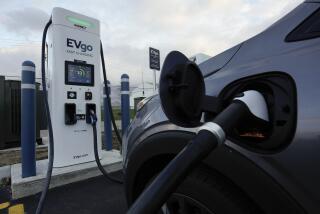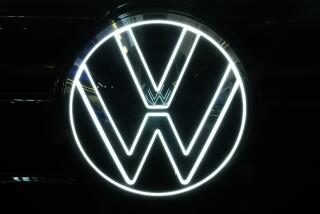Volkswagen Touareg Hybrid’s selling point is power, not fuel economy
Volkswagen recently put on sale the second generation of its mid-size sport utility vehicle, the 2011 Touareg. Sitting at the top of the Touareg line is the $61,385 Hybrid, a vehicle that is eminently capable and well-executed.
Yet, with a single exception, almost every argument you can make for buying the Hybrid may be called into question by Volkswagen’s other two Touaregs, the base V-6 and the V-6 turbo diesel (TDI).
Like your appendix (or even your wisdom teeth), the existence of the Touareg Hybrid is largely superfluous.
Its only advantage? Raw power.
The goal of the Touareg Hybrid is to give buyers V-8 power with V-6 fuel economy. It does this in spades. (Good thing, since a V-8 isn’t available on this generation Touareg.)
To move this hybrid, VW rummaged around the corporate parts bin and found a 3.0-liter supercharged V-6 used in various Audis. The automaker paired it with an electric motor and got a total output of 380 horsepower and a whopping 428 pound-feet of torque.
With a 0-60 acceleration time of 6.2 seconds, this is not so much a “save the whales” hybrid as it is a “you’re crowding my on-ramp” hybrid.
On all 2011 Touaregs (named after a nomadic tribe in Northern Africa), an eight-speed automatic transmission routes power to all four wheels. (In VW parlance, the all-wheel-drive system is known as 4Motion; Audi calls it quattro.) The handling is taut, with average steering feedback, though at 5,135 pounds, a sports car this is not.
The transmission features a Sport mode and it can be shifted manually. VW says the final two gears are essentially overdrive gears for increased fuel economy.
Also boosting the Touareg Hybrid’s efficiency is its unique ability to shut off the engine completely any time you take your foot off the accelerator, at speeds of up to 99 mph. VW calls this “coasting” and it happens by way of a clutch that decouples the engine from the transmission.
It’s quite a thrill to watch the tach drop to 0 rpm the moment you take your foot off the gas, be it on the freeway or coming up to a stop sign. The instant you tap the accelerator again, the engine kicks back to life without any discernible hesitation. It also makes for a very quiet and smooth ride.
But this feature is not enough to make the Hybrid the most efficient Touareg in the lineup, and power remains its only advantage.
The Hybrid is rated at 20 miles per gallon in the city and 24 mpg on the highway. During my week with the vehicle, I averaged 19 mpg. This shows the Hybrid’s advantage over a V-8; last year I tested the Touareg’s close cousin, the Porsche Cayenne S, and averaged 17 mpg.
But the efficiency badge goes to the $48,770 Touareg TDI. Its 3.0-liter, 225-horsepower, 406-pound-feet, oil-burning motor is rated at 19 mpg in the city and 28 mpg on the highway. I averaged 23.8 mpg over four days.
I would gladly trade the Hybrid’s straight-line acceleration for the TDI’s ability to get well over 500 miles on a tank of fuel, especially with a turbo diesel that can access all of its torque at a ridiculously low 1,750 rpm. Most gas engines are still putting in their contacts that early.
And don’t think the Hybrid has a towing advantage either. All three Touaregs are rated to tow an impressive 7,700 pounds, regardless of engine choice.
Finally, the Hybrid isn’t lighter or cheaper. Nor are there any distinguishing exterior features, save for small Hybrid badges, to denote that your $61,385 Touareg Hybrid is not the $45,270 base Touareg V-6 (which comes with a 3.6-liter engine good for 280 horsepower and 265 pound-feet of torque).
In fact, all new Touaregs look the same regardless of the trim line. This is a good thing, as visually this Volkswagen is better looking than the first generation. Volkswagen firmed up the lines and hardened the Touareg’s edges. This contemporary, refined look is enhanced by chrome roof rails and trim around the windows and standard LED daytime running lights and alloy wheels.
Inside, the refinement continues. This Volkswagen is basically an Audi hiding behind a VW logo.
All Touaregs come with an 8-inch touch-screen navigation system with a 60-gigabyte hard drive, a rear backup camera and — sitting between the speedometer and tach — a wonderful 7-inch information screen that looks like it was ripped out of an Audi A8. The controls demonstrate elegance in their simplicity, as does the subtle use of brushed metal and soft plastics.
Also standard on all Touareg are six airbags, anti-lock brakes, stability control and hill-hold assist. The safety quotient goes one step further, as the 2011 Touareg garnered a Top Safety Pick designation from the Insurance Institute for Highway Safety.
These standard features mean you’re getting a lot of kit on the base V-6 and the TDI. The top-end Hybrid comes fully loaded with such items as heated rear seats, 20-inch wheels, keyless entry, panorama glass sunroof, a premium sound system and parking sensors. The only option you can add is a trailer hitch.
Once you start getting into the Hybrid’s $60,000 range, however, it’d be nice to see additional features such as a lane-departure warning system, blind-spot monitoring and adaptive cruise control. None of these are offered, though they’re becoming commonplace on vehicles costing as much.
Interior space is up slightly over the outgoing Touareg, though rear visibility is still an issue on all Touaregs, as the high beltline and sloping roofline mean less glass in the back to see out of.
The Touareg seats five comfortably, with plenty of legroom to go around. Headroom is only marginally compromised because of the sunroof, but the sheer amount of light that this massive option allows into the cabin is worth it.
So the V-6 is cheaper yet still packed with plenty of content, while the TDI wins in efficiency. Still, if you’re comfortable spending $61,000 on an SUV that says VW on the outside but implies Audi on the inside, the Touareg Hybrid is easy to live with.
Say that about your wisdom teeth.
david.undercoffler@latimes.com







